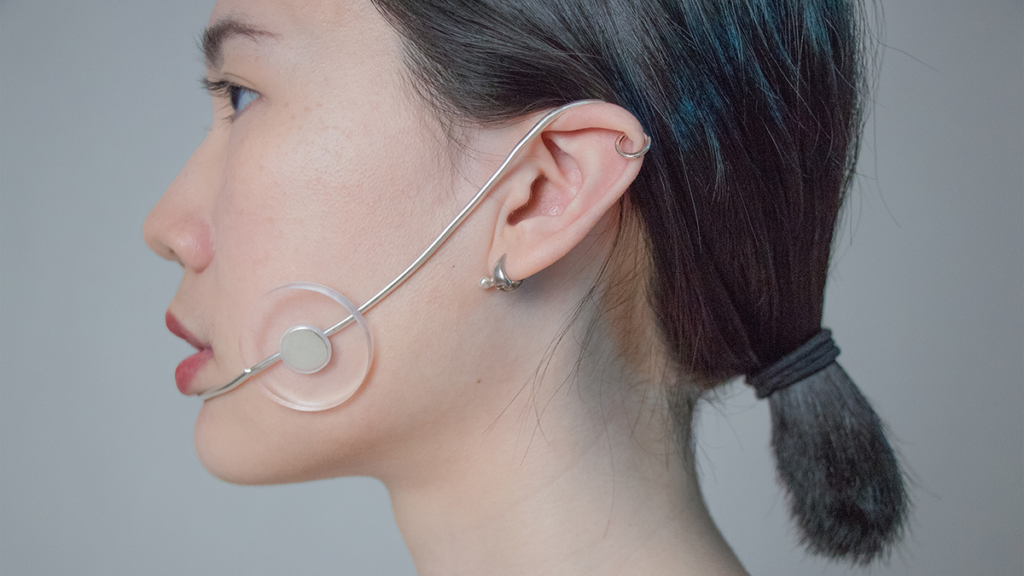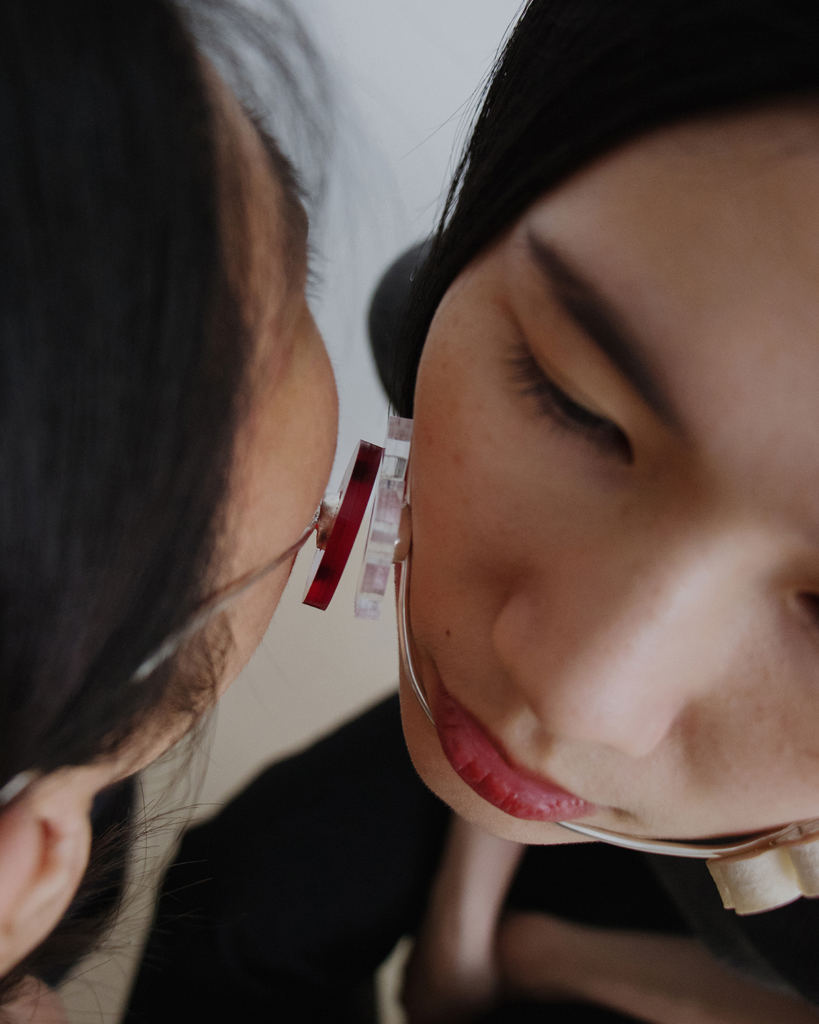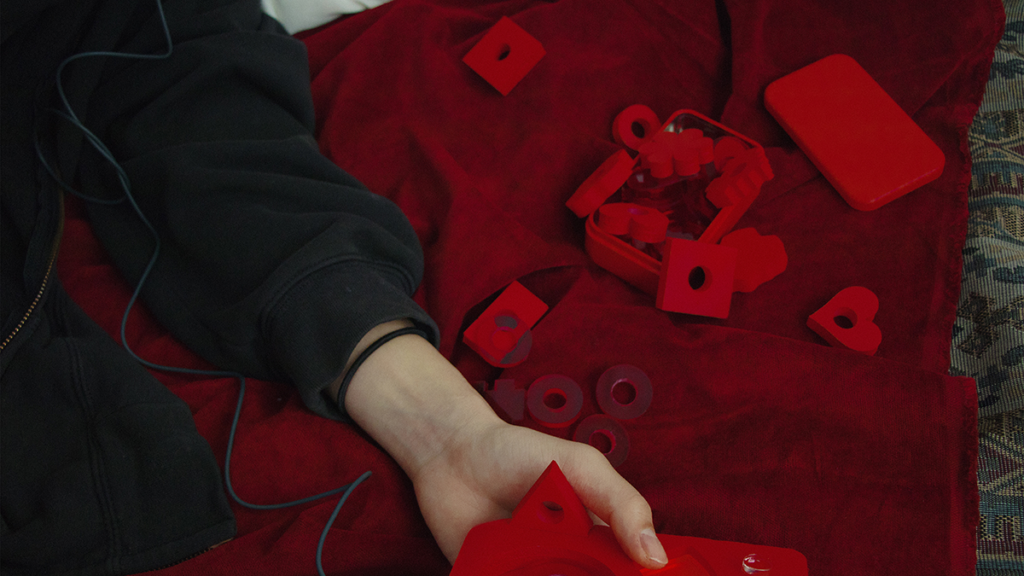原本利用網路就能搜尋到的個人資訊,全歸個人私有。在這裡,為了認識彼此,人們戴上了能傳輸個人資訊的飾品——KEYss。
In this world, personal information that used to be displayed publicly online is now made into individual property. Put on KEYss – a wearable device that stores and transmits private data – to get to know another person.

KEYss的發想來自西方的吻頰禮。吻頰⽂化最早是由羅馬帝國帶入歐洲及北非地區。但在14世紀時,吻頰曾經因為瘟疫⽽消失,到了⼀戰後才回到⼈們的⽇常⽣活。 關於吻頰回歸的原因有許多不同的解釋。其中,由法國⼈類學家David Le Breton提出的觀點,闡述了為何吻頰會存續在⻄⽅⽂化當中。David Le Breton認為,成年⼈不像孩童⼀樣,總是會受到他⼈摸頭、親吻等疼愛的肌膚接觸。⽽吻頰給了成年⼈⼀個正當的理由,讓他們得以觸碰別⼈的臉頰,並藉著這個動作,向對⽅展現⾃⼰的關愛與尊重。最重要的是,獲得吻頰伴隨⽽來的親密感。
The idea of KEYss sprouts from the greeting etiquette of cheek kissing. It was the Romans who popularized the tradition of cheek kissing, spreading it throughout Europe and North Africa as their empire grew. Yet during the 14th century, people stopped doing it altogether as a result of the plague, and it didn’t make a reappearance until after the First World War. There are various reasons for why the greeting kiss lives on in the Western culture. Anthropologist David Le Breton believes that, while children are the subject of countless kisses from everyone, this isn’t the case in adulthood, and “la bise” gives adults a rare and important opportunity to touch the face of another person, to show affection, friendship or respect, which involves a certain degree of closeness.

KEYss is made up of two parts – KEYss itself and the file disc.
人們能將任何檔案,例如音訊檔、圖檔儲存在圓片裡,將圓片的卯口插進KEYss上的榫頭後,便能與他人吻頰以傳輸檔案。透過吻頰來傳輸個資,其代表的意義是:一個人在獲得跟你有關的情報前,必須先和你建立一定程度的親密感,才有資格一窺你的個人資訊。
The disc stores everything from audio to image files. After we insert it into KEYss, data transfers through cheek kissing, symbolizing that one must first build a certain level of intimacy with you, before getting a glimpse of your personal data.

跟人有關的一切最終都能被收攏成一串數字。但那裡沒有過程,得出的結果太過扁平。人是擁有形體的存在,親自與世界碰撞所得到的,才是我想相信的真實。當記憶與資訊也同樣有了體積和重量、形狀和質地,人與人身體的距離成了心理距離的隱喻,縮短這些距離才能交換彼此的一部分——如此一來,我們是否能創造出一個既私密卻也毫不保留的世界?
Everything that has something to do with humans can eventually be summarized into a string of numbers; however, the process is lost in the middle, and the result is too flat and plain. Human beings exist with physical forms, therefore, the moment of truth that I would like to believe in, is when our bodies collide with the world. When memories and information also gains volume and weight, shape and texture, the actual distance between people’s bodies becomes a metaphor for psychological distance, and it is only by reducing these distances that we can exchange parts of each other – in this way, can we finally create a world that is both private yet unreserved?


•••
Note
1. “Sheril Kirshenbaum (2011), “The Science of Kissing: What Our Lips Are Telling Us”
2. Christopher P. Jones (2002), “Ancient Kissing”
3. Stehli Jean-Sébastien & François Virginie (1999), “L’art de la bise”
•••
溫敏喻, 《KEYss》,
互動裝置70x150x150mm, 5x40mm, 2022
指導 何樵暐
總召 余能豪
銀飾製作 Cyco
論述翻譯 徐逸珊
攝影協力 王淨薇, 服部智章, 鄭怡瑄, 曾筠恩, 溫立楷 特別感謝 何華芸, 邱莉媛, 黃齡瑩, 陳采琳



98 Comments
98 Pingbacks